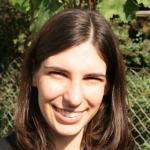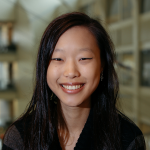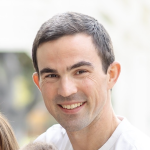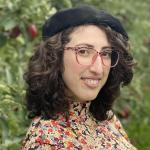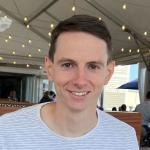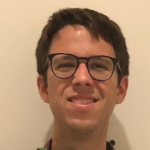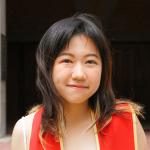People
Staff Members
Andrew Benson
Andrew Benson is a Staff Scientist at the Carnegie Observatories. His research program is focused on understanding the nature of dark matter and the process of galaxy formation, with a particular emphasis on formulating a coherent picture of the many different aspects of these problems. He has developed a model of dark matter and galaxy formation physics, Galacticus, which is available to the community as an open source project. The approach blends both analytic understanding and significant number-crunching that utilizes both in-house and external compute clusters.
Ana Bonaca
Ana Bonaca is Staff Member at Carnegie Observatories. Her specialty is stellar dynamics and her research aims to uncover the structure and evolution of our galaxy, the Milky Way, especially the dark matter halo that surrounds it. In her research, she uses space- and ground-based telescopes to measure the motions of stars, and constructs numerical experiments to discover how dark matter affected them.
Juna Kollmeier - Founding Director
Juna Kollmeier is the Founding Director of CTAC and the Director of SDSS-V, an unprecedented panoptic spectroscopic survey that will yield optical and infrared spectra of over 6 million objects. Her research is primary focused on the emergence of structure in the universe. She combines cosmological hydrodynamic simulations and analytic theory to figure out how the tiny fluctuations in density that were present when the universe was only 300,000 years old, become the galaxies and black holes that we see now, after 14 billion years of cosmic evolution.
Anthony Piro
Anthony Piro is interested in a wide range of topics in theoretical astrophysics, including compact objects, astrophysical explosions, accretion flows, and stellar dynamics. His expertise is in nuclear physics, thermodynamics, condensed matter physics, General Relativity, and fluid and magnetohydrodynamics. He uses this background to predict new observational phenomena, as well as to understand the key underlying physical mechanisms responsible for current observations. He uses a combination of analytic and simple numerical models to build physical intuition for complex phenomena.
Current Postdocs
Sten Delos
James Johnson
James Johnson is a CTAC postdoctoral fellow broadly interested in galaxy evolution and the origin of the elements. Most of his work is centered on applying theoretical models of galactic chemical evolution to spectroscopic elemental abundance measurements of resolved stars in the Milky Way and nearby dwarf galaxies. Lately, he is particularly interested in what can be learned from these comparisons regarding how different elements are made in stars. James also dedicates a portion of his time to developing astrophysical software tools for broader use by the community.
Stacy Kim
Stacy Kim is a Nashman/CTAC postdoctoral fellow involved in the search for the particle identity of dark matter. She runs high-resolution, cosmological hydrodynamical simulations of the smallest and most dark matter dominated objects in the universe---dwarf galaxies---as a part of the EDGE Collaboration, and in particular leads the effort to run them with alternative dark matter physics. Informed by these simulations, she builds models to understand how dwarf galaxies' formation and evolution are affected by their dark matter content. She uses these models to determine the signatures that different dark matter particles leave on large populations of dwarf galaxies, and test if they can be detected by current and upcoming surveys
Brenna Mockler
Brenna is a CTAC postdoctoral fellow interested in using high energy transients to learn about the growth and evolution of supermassive black holes and the environments that they live in. Most of her research is at the nexus of theory and observation, building theoretical models of what the emission from transients looks like and connecting them to observations. She is a particular expert on tidal disruption events, and one of the lead developers of the MOSFiT transient fitting code.
Ethan Nadler
Ethan Nadler is a joint postdoctoral fellow at the Carnegie Observatories and USC. His research combines cosmological simulations, particle theory, and observations of the smallest galaxies and cosmic structures to understand the microphysical properties of dark matter. He also works at the interface of data and dark matter theory with collaborations including the Dark Energy Survey, Dark Energy Science Collaboration, and Satellites Around Galactic Analogs Survey.
Nondh Panithanpaisal
Nondh Panithanpaisal is a joint postdoctoral fellow at the Carnegie Observatories and Caltech. His research focuses on disrupted star clusters known as stellar streams. Using state-of-the-art cosmological baryonic simulations of Milky Way-mass galaxies, he identifies and studies dwarf galaxy streams to constrain the nature of dark matter. At Carnegie, his research aims to develop numerical simulations that include globular cluster streams, which can be used to indicate the presence of substructures within the Galaxy.
Andrew Robertson
Andrew works on producing mock data for the Roman telescope's galaxy redshift survey. He has previously worked on astrophysical tests of the nature of dark matter, running cosmological simulations with different dark matter models and then comparing them with the observed Universe. The ability to map out dark matter is an important part of these comparisons, so Andrew works on gravitational lensing, where the distribution of dark matter can be inferred from the way that in which it distorts the images of background galaxies. Andrew is also interested in galaxy clustering, redshift-space distortions, galaxy clusters and strongly lensed gravitational waves.
Natalie “Nicole” Sanchez
Natalie “Nicole” Sanchez is a National Science Foundation MPS-Ascend Postdoctoral Fellow at Carnegie Observatories and Caltech. She is a member of the N-Body Shop collaboration and the GM Galaxies team, and she uses cosmological simulations of galaxies to better understand galaxy evolution. Nicole is particularly interested in understanding the mechanisms which drive the metal enrichment of the circumgalactic medium, especially the effects of supermassive black hole feedback.
David Vartanyan
David Vartanyan is a Hubble Einstein fellow working on the next generation of core-collapse supernovae simulations from bounce to breakout. His interests lie between high-energy astrophysics and high-performance computing. He is interested in deriving remnant properties, including mass distributions and ejecta abundances, from first-principle driven simulations that can reproduce the gamut of supernovae observations.
Newlin Weatherford
Newlin Weatherford is a CTAC postdoctoral fellow specializing in stellar dynamics. He uses state-of-the-art simulations of star clusters to study how stars escaping from these clusters produce elongated substructures in our Galaxy known as stellar streams. Modeling these streams and perturbations to them is essential to understanding the history of our Galaxy and potentially to inferring the nature of dark matter. He also studies the dynamics of star clusters' central black hole populations and develops methods to detect them. This work is relevant to the production of compact binaries, electromagnetic transients, and gravitational-wave events.
Sachi Weerasooriya
Sachi Weerasooriya is a postdoc at Carnegie Observatories working with Andrew Benson. She is interested in galaxy formation and evolution, specifically using Semi-Analytic models. She works on modeling galaxies for future surveys with a focus on accurate modeling of emission lines and calibrating models. She is also interested in dwarf galaxies and impact of major mergers on stellar streams.
Samantha Wu
Students
Jack Lonergan
Jack Lonergan is a graduate student at the University of Southern California, working under Andrew Benson. His research focuses on integrating machine learning algorithms with Semi-Analytic models to simulate galaxy formation and evolution, with particular emphasis on dark matter dynamics. Jack’s broader research interests include understanding the fundamental nature of dark matter and its impact on galactic structure across the universe.
Paul Menker
Paul Menker is a graduate student at the University of Southern California and USC-Carnegie. He works under Andrew Benson, and is broadly interested in the formation of the dark matter halos we observe today. To this end, he works with ensembles of plausible early universes, and attempts to reconcile these possibilities with observational data. At USC, he is also a member of the High-Energy Theory group, and the Graduate Association for Students in Physics.
Dimple Sarnaaik
Dimple Sarnaaik is a graduate student at the University of Southern California. She works with Andrew Benson on the formation history of dark matter through N-body simulations and analytic modeling. Simultaneously, she is working with Kris Pardo at USC on probing properties of dark matter through its gravitational effects and astrometry. She is also the President of the Graduate Association of Students in Physics at USC and is passionate about science communication.
Jimmy Wen
Julie Xue
Julie (Zijing) Xue is a graduate student at the University of Southern California working with Ana Bonaca as a USC-Carnegie Fellow. She works on uncovering density substructures of stellar streams through observations, and is broadly interested in using streams to probe dark matter on the smallest scales.
Former Postdocs
TJ Cox (2009-12) now Data Scientist at Voxer
Selma de Mink (2013-14) now Scientific Director at the Max Planck Institute for Astrophysics , Garching, Germany
Andrew Wetzel (2013-17) now Assistant Professor of Physics at the University of California, Davis
Stephanie Tonnesen (2014-17) now Associate Research Scientist at the Center for Computational Astrophysics at the Flatiron Institute
Jennifer van Saders (2014-17) now Assistant Professor at the Institute for Astronomy at University of Hawaii
Yu Lu (2015-18) now Senior Data Scientist at Lam Research Corporation
Stefano Pasetto (2016-2018) now Research Scientist at Moffitt Cancer Center and Research Institute
Yuan-Sen Ting (2017-2021) now Associate Professor at Australian National Univeristy
Coral Wheeler (2020) now Assistant Professor in the Department of Physics and Astronomy at Cal Poly Pomona
Lina Necib (2020-21) now Assistant Professor in the Department of Physics at MIT
Andrew Emerick (2020-2021) now Senior Data Scientist at Metromile
Lauren Anderson (2019-2021) now Data Science and Visualization Engineer at Heliogen
Xiaolong Du (2018-2022) now Postdoctoral scholar at UCLA
Kyle Kremer (2020-2022) now Assistant Professor at UC San Diego
Fangzhou Jiang (2019-2023) now Assistant Professor at KIAA
Ylva Götberg (2019-2023) now Faculty at the Institute of Science and Technology Austria
Shengqi Yang (2021-2024) now Director's Postdoctoral Fellow at Los Alamos National Laboratory
Abigail Polin (2020-2024) now Assistant Professor at Purdue University
Mike Grudic (2021-2024) now Associate Research Scientist – Software, Flatiron Institute
Former Students
Armen Tokadjian (2017-2022) now Postdoctoral Scholar at JPL
Annastasia Haynie (2017-2023) now Data Organizer with the United Auto Workers
Niusha Ahvazi (2021-2024) now GECO Fellow at the University of Virginia


